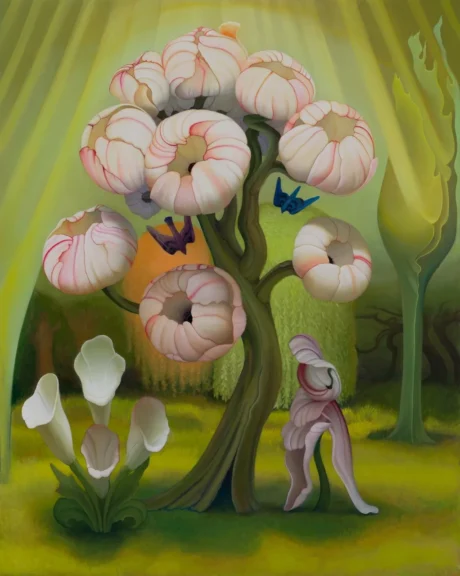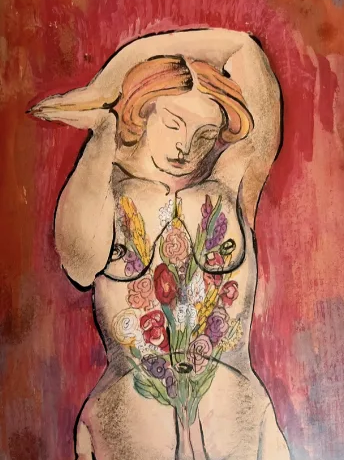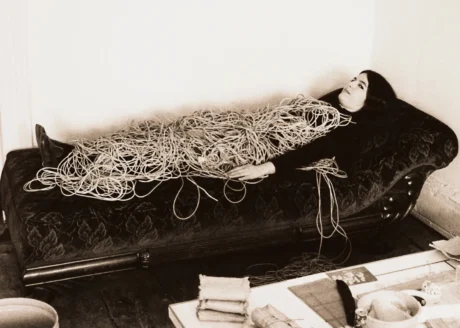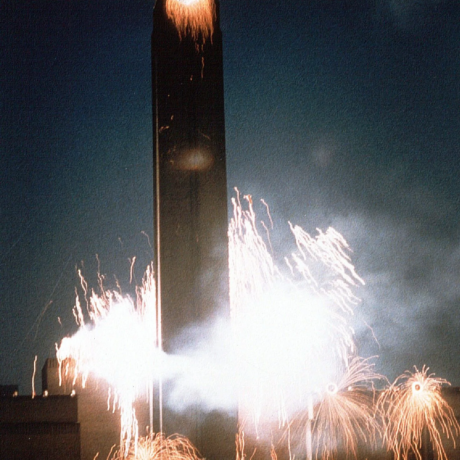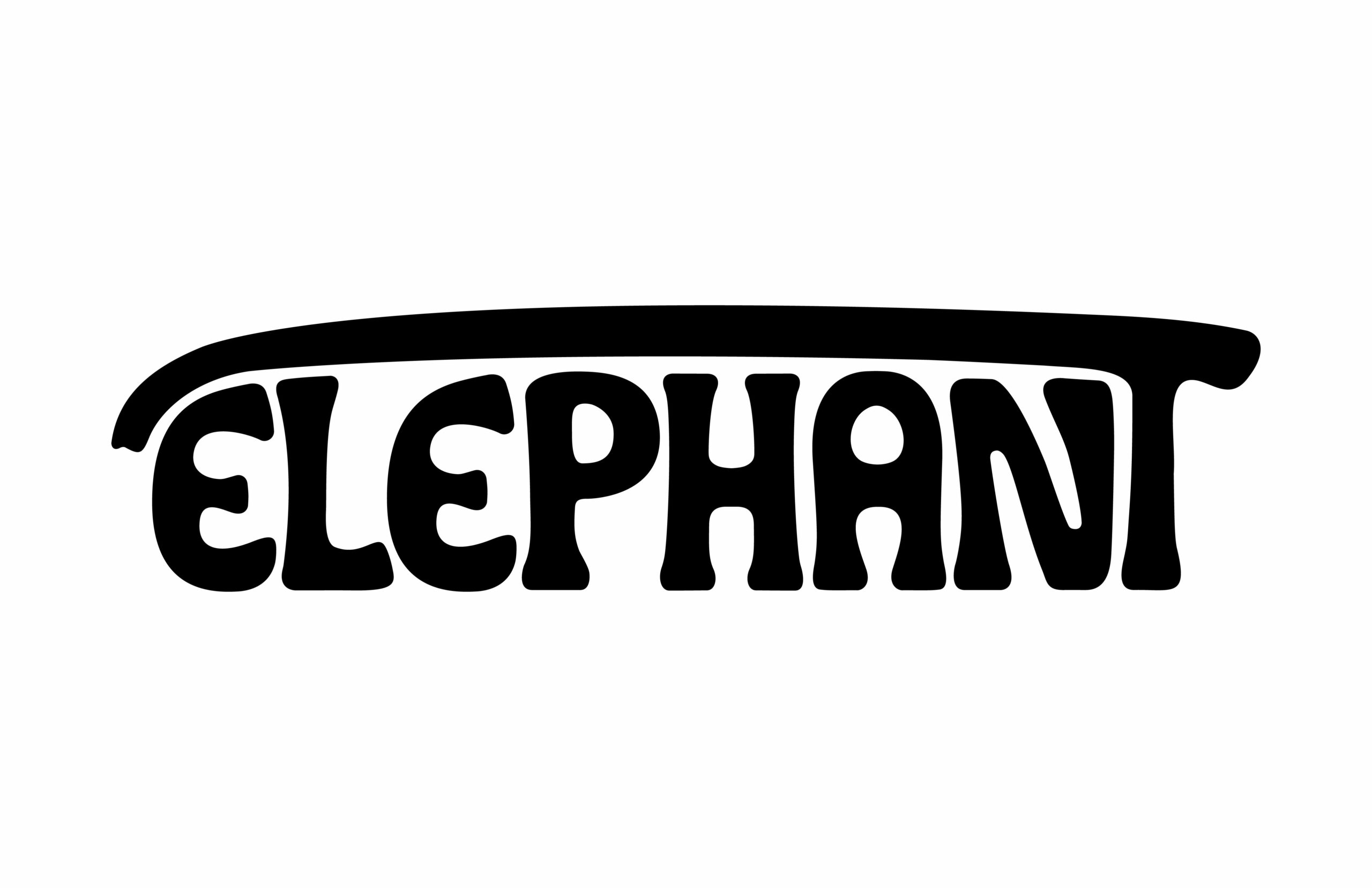Meka Boyle speaks with a range of LA artists and those working to salvage art from the ruins and begins to reflect on what’s to come for this community.
Juan Huerta Coello is making his way along the PCH to the outskirts of an evacuation zone. The young artist’s heavy duty personal protective equipment abates his worries about the toxic air. But when the wind blows, he can catch the scent of burnt eucalyptus. Above him, an aircraft from Canada hovers, spraying water and fire retardant on the hills. He turns up north when he hits the road closure at Will Rogers State Beach, where hundreds of firefighter trucks, police cars, EMTs, the national guard, and members of the press gather. The Pacific Palisades is closed off for entrance except for emergency workers, and art handlers like Huerta Coello.
Last month, he was installing work and making the occasional delivery. He never imagined he would be rescuing some of this same art from Los Angeles’ fires. Last week, he waited in his truck while a customer’s assistant ran up the hill into a fire zone to bring paintings to safety. Today, he walks through an ash-covered wasteland to arrive at a single standing house, the artwork undamaged. “It is like being on an island surrounded by destruction,” he says.
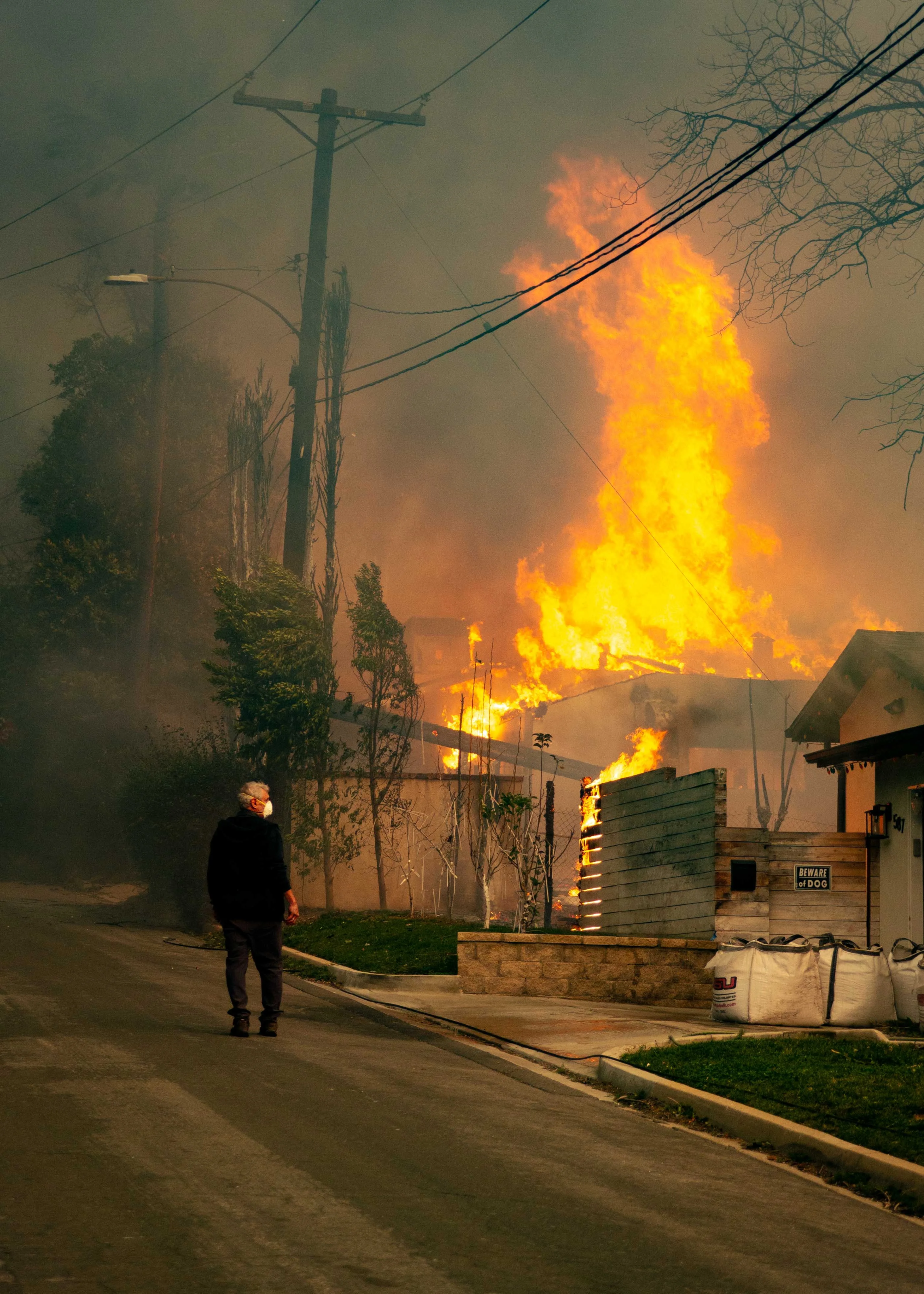
Since the fires began, the artist has been working virtually nonstop to rescue artworks from at-risk homes of the top 0.01 percent—billionaire investors, tech CEOs, Hollywood tycoons, and hedge fund managers. “A lot of us are very tired,” Huerta Coello says of his hectic schedule at one the top art storage and service companies in the country. On the most intense days of the fires, he worked upwards of 14-hour shifts. Some of his coworkers even stayed in company offices as temporary shelter when they had to evacuate their own homes.
Huerta Coello estimates that his team has recovered over 250 historical works (many which are regularly loaned to museums). Henri Matisse, René Magritte, Diego Rivera, Claude Monet, Louis Bourgeois, Gerhard Richter, Anselm Kiefer, Ed Ruscha, Robert Rauschenberg, his list goes on. The artist, who was born in East LA but grew up in Ecuador, where his parents are from, spent his formative years looking at photos of many of these paintings in books. When he went to art school in the Bay Area, he studied them. Now he feels a personal connection to the works. “I’ve been taking every single job because I don’t want to see the art get burned.” As we speak, the Santa Ana winds are still blowing through Los Angeles, and new fires are erupting yet the worst seems to be behind us. While some people are still evacuating, others like Huerta return to sort through the rubble.
“When I clock out, I just come to my little home in Echo Park, back to reality,” he says, adding that many of his artist friends in Altadena have lost their entire archives. “It’s heartbreaking. Just because a work is historical, it doesn’t mean that it has some sort of superior emotional value.” Today Huerta Coello is leaving work early; he will go to his studio and paint.
Meanwhile, in South LA, Martine Syms is at home on her computer, navigating broken government websites and glitchy support forms. “Nothing works,” the artist tells me. As Huerta Coello races time to save art from an uncertain fate, Syms processes a more liminal loss. She is helping her parents, whose home burned down in the Eaton Fire, navigate the complicated relief system. They are staying at an Airbnb until the end of the month, she explains. Then what? “I’m not sure,” she answers, pausing. “I’m trying to figure that out.”
Her phone rings constantly with calls from those offering support, as well as those in need of advice. Her studio has transformed into a de-facto donation center. “It is a no-brainer to me. I’m trying to make sure people are okay because they’re not, and they’re not going to be for a while,” she emphasizes, rattling off a list of names of those around her doing the same. What else are you supposed to do?
Syms remembers her mother’s family photo collages that hung on the walls, her own early artworks stored away, the oak tree in the front yard. She lets out a sigh of relief as she remembers how in 2017 she scanned over 4,000 family photos for her film Incense, Sweaters & Ice. She longs to return to see what remains with her own eyes.
She wasn’t home that night to witness Altadena burning, but the pictures haunt her: “There’s power lines down. There’s cars on fire. There’s black smoke filling everywhere,” she says, describing a photo her sister sent her. “By the time my brother got to our house, it was completely gone. The house across the street exploded. The house up the street was actively on fire.” Her childhood friend, the artist Kenturah Davis, who grew up a couple blocks away, lost her own home and her family home, too. “It’s insane when it’s everyone you know and their parents. It’s a lot of trauma.”
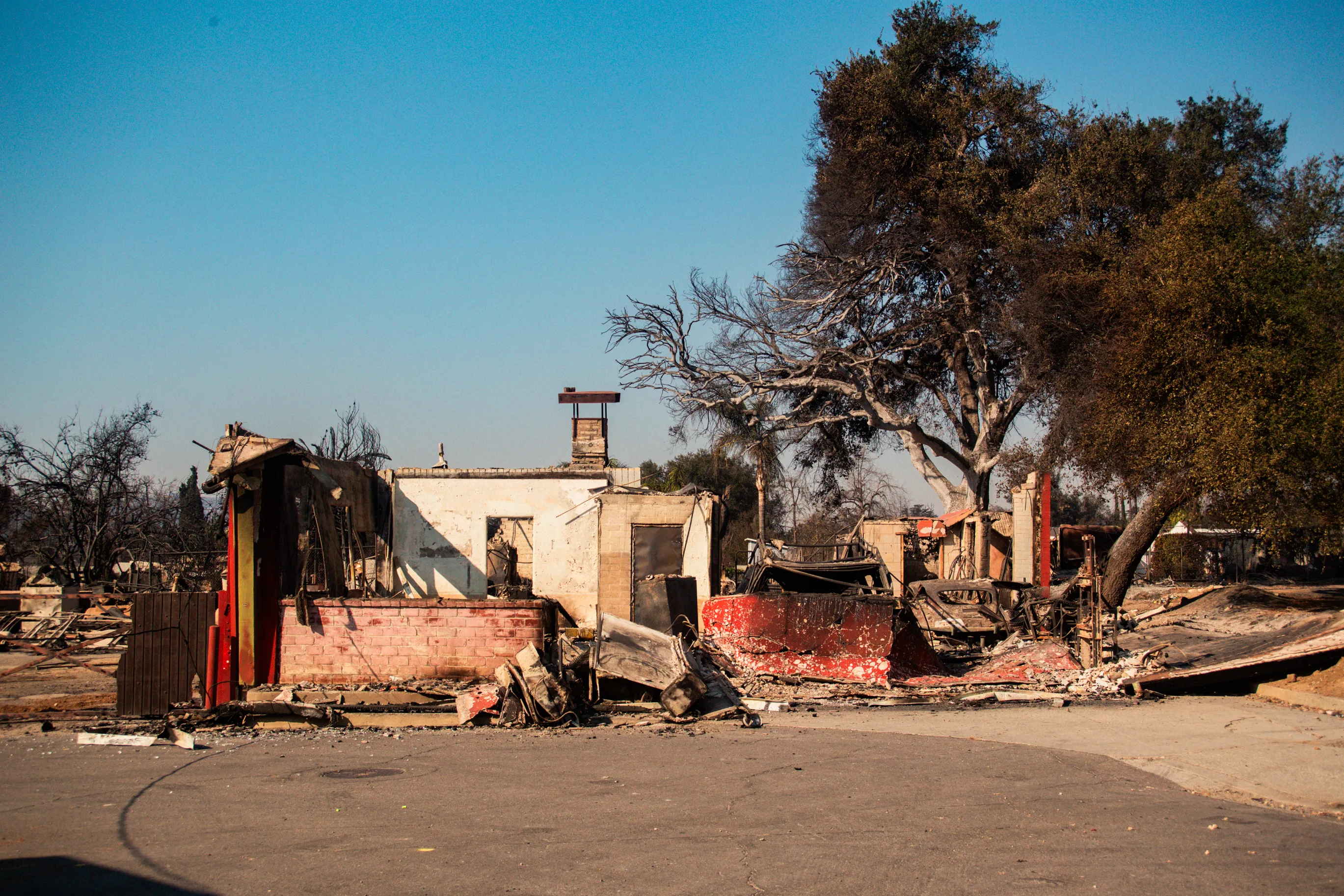
It has been two weeks and counting, and a claustrophobic national guard and police presence ensures no one can enter Syms’ family neighborhood—a historically Black, middle class enclave that was once the only place in LA where people of color could purchase a home. “I asked, ‘When can we go back?’ They told me, ‘We don’t know.’” No answers led to more questions, so she went to town halls looking for information, and found support in her community: Friends cooked meals for her parents, brought over clothes. A deep sense of solidarity emerged.
“It’s something I’ve known for a long time, that you only have your community, and my community—both my Altadena community, my artistic community, my friends—have shown up in major ways.” Syms pauses to gather her emotions. “There’s nothing else.” A tremble, then steadfast: “There’s nothing else.”
Throughout Los Angeles personal losses accumulate into a collective grief. While Syms navigates the heartache of losing her childhood home, she is not alone. The city may be shaken, but it reverberates with resilience. Even in the wake of devastation, Los Angeles has always been defined by its ability to transform. “This is a pivotal moment in LA, and our generation is shaping it,” she says. “There’s going to be a new Altadena. There’s going to be a new Palisades. There’s going to be a new LA. What do we want it to be?”
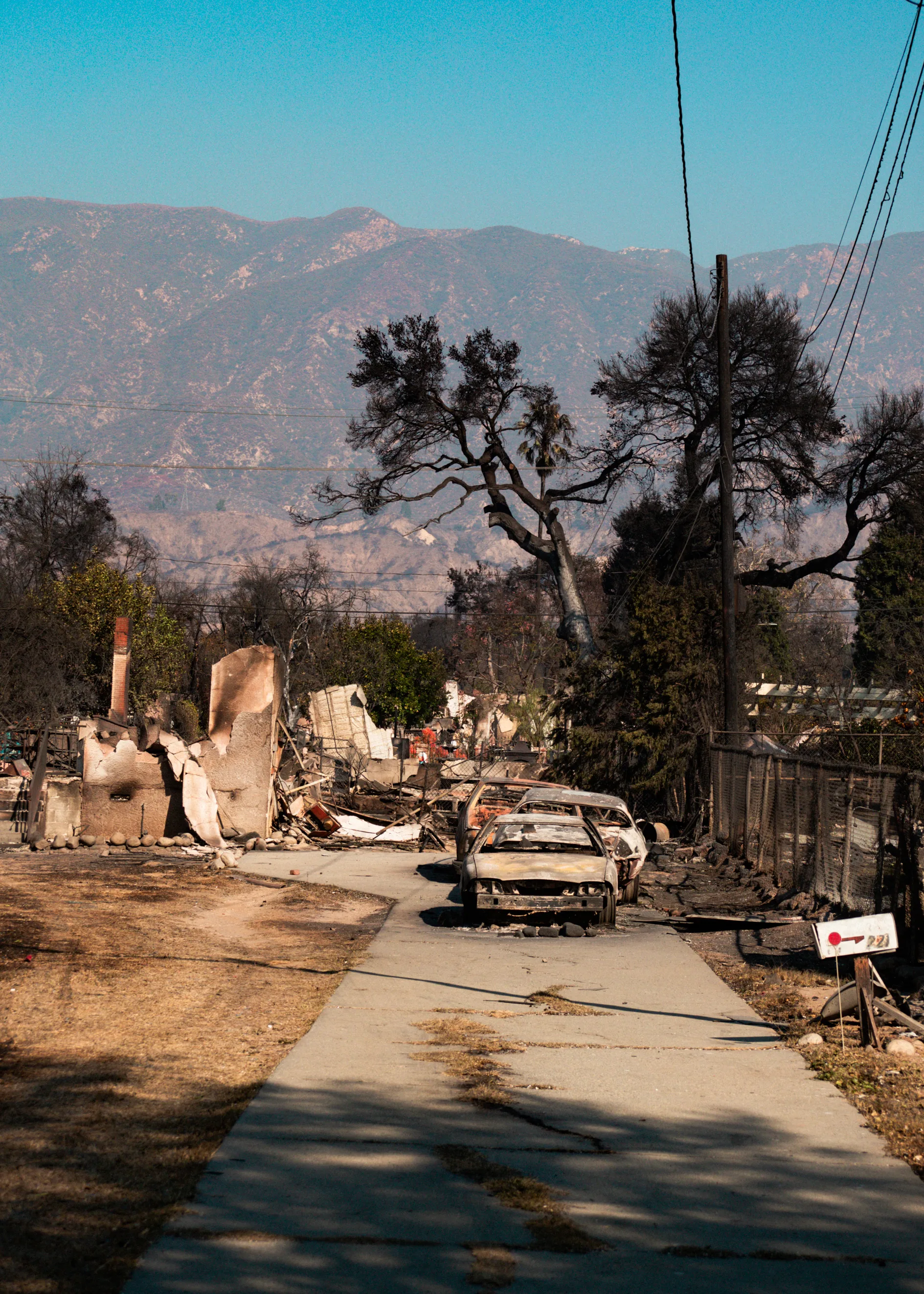
Across town at the Westside Pavilion-turned-FEMA recovery center, Kathryn Andrews waits in line in the morning as some-100 staff and volunteers prepare to open aid stations. “I know from experience that the impact unfolds over time,” says the artist. This is the second time she has lost her home to a fire; the first was in the 2020 Bobcat fire.
Soon after the fires broke out, Andrews—who recently founded Judith Center, the nonprofit research and art center for gender equality—decided to channel her loss into action. She and artist Andrea Bowers co-founded Grief and Hope along with three other women in the art world. In the days since, their successful fundraising campaign has gained support from non-profit gallery the Brick, along with additional proceeds from auctions, fundraisers, and various relief projects. As of today, they have received 321 responses from artists seeking aid and raised $843,902—they have their sights set on $1 million. “The response has been really moving. I’ve seen how strong our network is. It’s a true community,” says Andrews as FEMA announcements pick up in the background.
Like the 100,000 other Los Angelenos displaced, Andrews’ most pressing concern is finding a home in the city’s competitive housing market, where landlords have been criticized for spiking rent in recent days. Her long-term concern is how to deal with the toxic aftermath before it spreads further into the ocean, the air, the land.
How do you measure grief when circumstances force you to fill its absence in order to survive? How do you pick up the pieces when the ground is still hot? Andrews pours her energy into fundraising. Her neighborhood, a longstanding patch of mobile homes along the PCH, was decimated by the fire. She lost art traded over the years, her own work, her personal belongings, her sanctuary. “It was right by the ocean, with incredible foliage, trees, and wildflowers,” she says. “It was a very magical place.” Every afternoon, she would pass by the community hot tub and see groups of elderly women enjoying themselves.
For those affected, like Andrews, grief contracts and expands in-between bureaucratic checklists and moments of reflection. “Memories are really the only form of evidence of life before in these areas,” says the painter Marcus Leslie Singleton, whose solo show opened at the Journal Gallery in West Hollywood, and whose great aunt and uncle lost their home in Altadena the following week. Now, his exhibition is doubling as a fundraiser for fire victims.
“The future will look completely different, not only physically but the feeling of these neighborhoods,” says Singleton.
High up in the Altadena foothills, ash and rubble accumulate where paintings once hung: over a stream, on a concrete wall, and in a gazebo around Ross Simonini’s home. Ruins remain where sculptures once did, in a rose garden and in the shed, and where Simonini’s own paintings once populated the walls inside. The artist and writer wistfully recalls the final exhibition he and his wife, Katie Simonini, staged on their property. “It was a beautiful Sunday morning under the San Gabriel mountains.”
Today, these mountains are barren and blackened. Nothing is left. Nearby, the artist Paul McCarthy’s long-time home suffered the same fate. All that remains is his bronze statue of Pinochio and a snail he made in collaboration with Jason Rhoades. Ruby Neri’s entire archive, recently relocated to her home-studio: gone. The devastation spills out into the larger community, too: the writer Ikechúkwú Onyewuenyi tells me of his wife’s OB-GYN, Dr. Rashida N’Gouamba, who lost everything in the Eaton Fire. “She’s still delivering babies, still on call, still in the maternity ward,” says Onyewuenyi. His family’s house, 10 miles away, was lucky. But what about the next time?
“We need to see how, even if we didn’t lose something physically or materially, we are slowly losing something,” Onyewuenyi says. “One day it will affect us in a very material, tangible way. That’s important to sit with.”
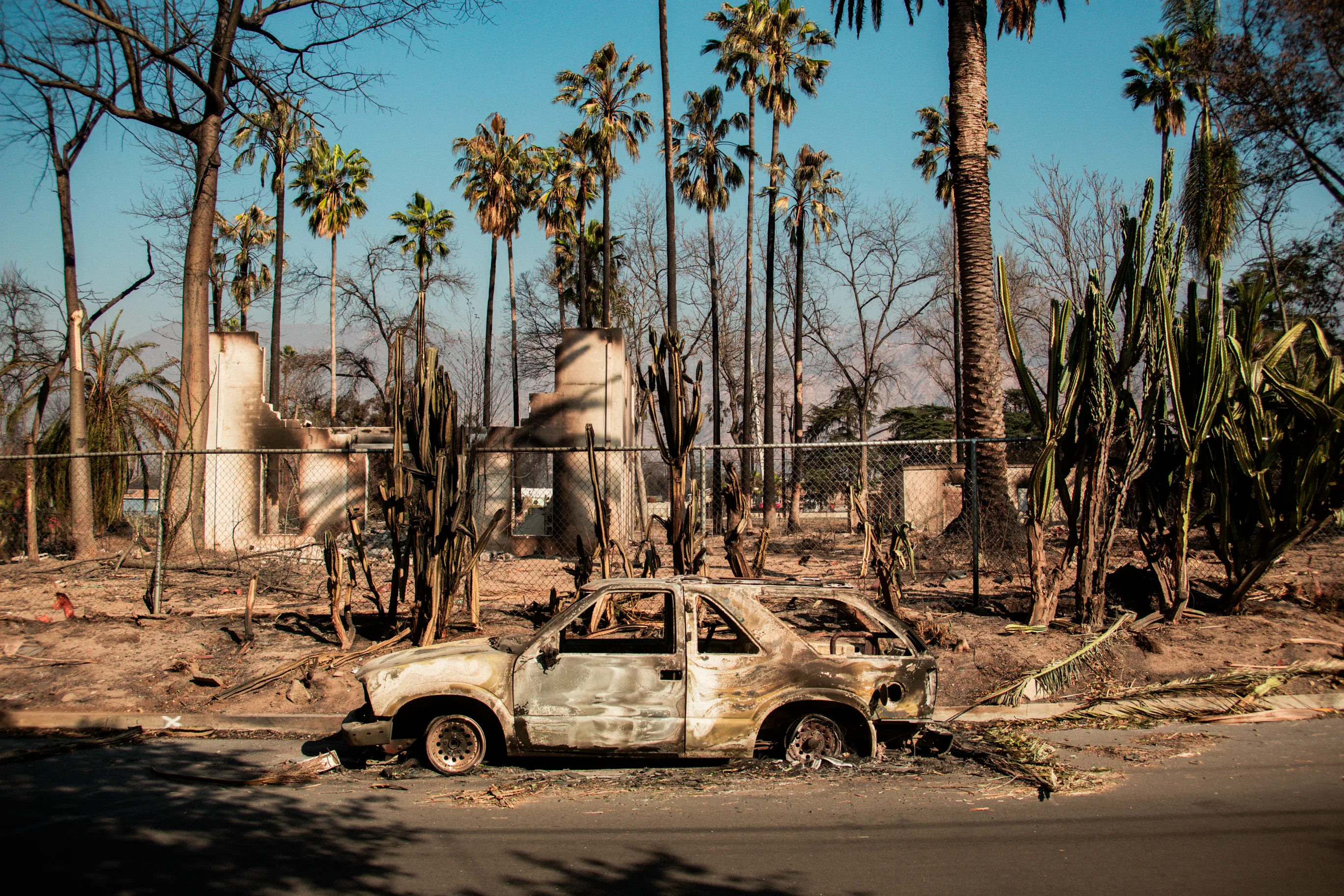
Will it take us, each and every one, to experience the fleeting nature of life—of objects and places tied up to our being—until we can grasp the collective societal erosion we’re facing with climate change?
As a child, on ash Sunday the priest would run his finger through the burnt palm fronds and drag it across my forehead in a cross. “You are dust, and you will return to dust,” he told me like a mantra. For a while this was the closest I would get to comprehending impermanence. That something, someone could be here one day and gone the next.
You are dust, and you will return to dust. My friend tells me how after her house burnt down, her salvaged keepsakes never stopped smelling like smoke. One day the world will burn so hot and incessantly that it will consume the things we love. We will all know how it feels to utter the words: It is gone. We will no longer be able to ignore it. The smell will follow us everywhere (like trauma lingers long after physical loss). How can we slow the impending scorched earth that mankind’s greed and shortsightedness has wrought? We must look to the past: to the warnings of Octavia Butler, the wisdom of the Chumash, Tongva, and Kizh tribes.
Climate change is the antithesis to capitalism. Every year, wildfires across California increase. Seventy-five percent of the state’s 20 most destructive fires have happened in the last 10 years. Our faces scorched, throats dry, we pray for the rain. But after fire, comes mud slides.
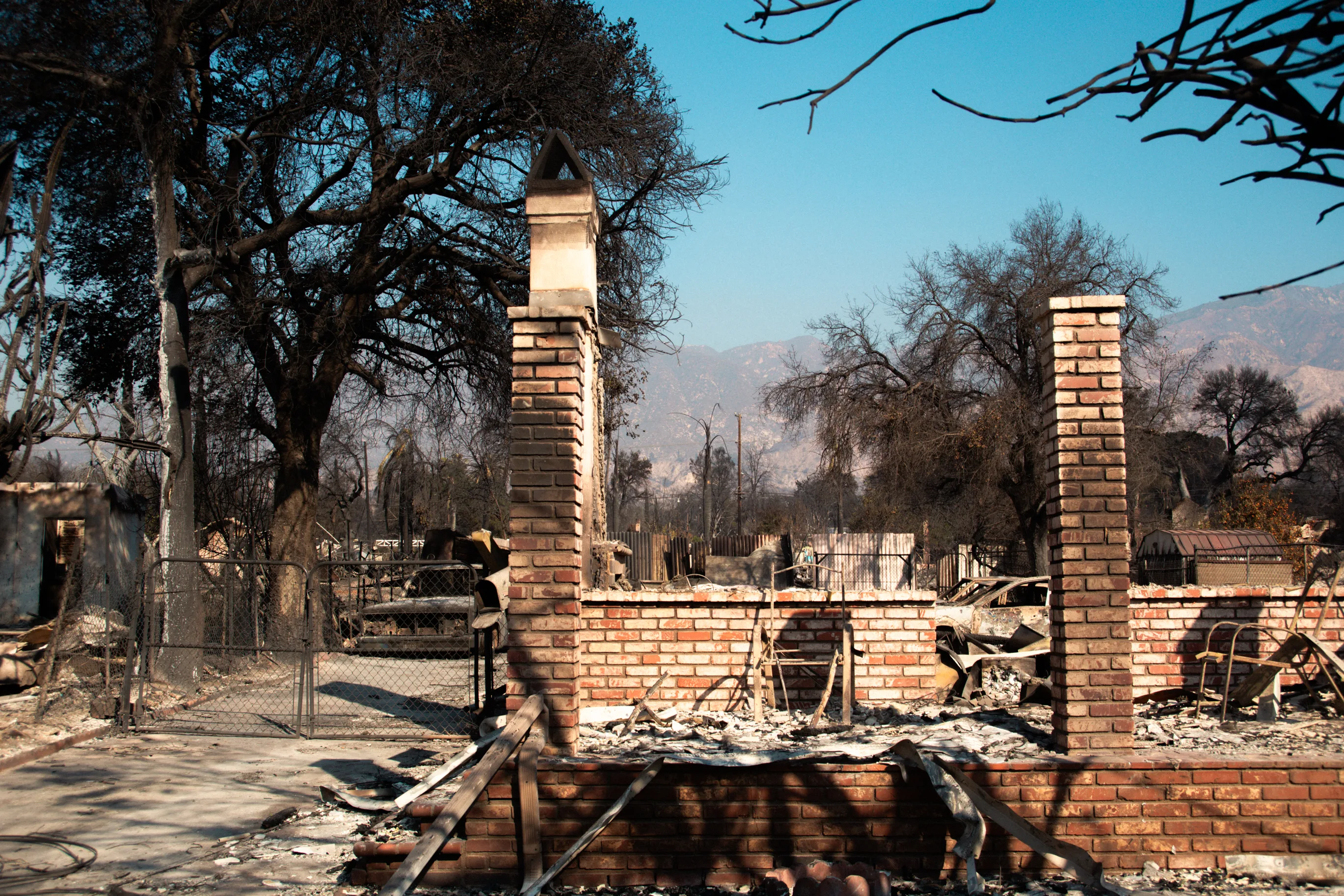
We must assess the present: prisoners sent out to fight fires without the proper training or pay. Flammable, petroleum-laced material built to quickly and efficiently house but not to protect. Asbestos and lead leaking into the air. In America, we create fire, then we put it out. The cycle repeats on an endless loop, accelerating with each time, and yet the government can’t put its finger on the blame. Donald Trump pulled out of the Paris climate agreement, and fossil fuel companies continue to profit despite their deathly tolls. Wildfires burn now, more than ever, and systemic issues like racism, poverty, and inadequate infrastructure have intensified these disasters for those already on the margins.
We fixate on the symptoms and refuse to address the root causes—and how can we not—a nation divided, human rights reduced to hot-button debate topics. Our society treats others and the natural world with the same disregard. We must confront this colonial framework head on, and find solutions in the margins. As the debris piles up and fires rage on, it’s clear that this isn’t just about immediate recovery, but about reckoning with a failed system. Our physical structures have burned to the ground, as has our ideology, leaving a crater, a hole to fill.
So far, Los Angeles is pushing on. Community support is a silver lining that draws a circle around the lack of institutional support. Artist-led mutual aid groups are distributing resources for housing and art supplies. LA museums launched a $12-million emergency fund. Neri just opened her first solo museum show at Manetti Shrem in Davis, California. Frieze is still scheduled, and so is Felix. Art galleries are selling out fundraising shows. Artists are lending their studios and holding space for each other.
Someone once told me that Los Angeles is like a nervous system without a brain, a city of suburbs sprawling out without a center. Now, I imagine its head is in the clouds, breathing the air above the smoke, waiting for us to save it.
Artist GoFundMe’s: Kathryn Andrews, Eddie Rodolfo Aparicio, Rebecca Baron, Erin Berkowitz, Sula Bermudez-Silverman, Seth Bogart, David Bratton, Brian Lee Clements, Kevin Cooley, Kenturah Davis, Margaret Griffith, Jeff Herring, John Knuth, Daniel Mendel-Black, Chris Miller, Sunny Mills, Francisco Mora, Kate Mosher Hall and Rachelle Sawatsky, Ruby Neri, Jane Orr and Sam Richardson, Cleon Peterson, Christina Quarles, Grayson Revoir, Jean Robison, Adam Ross, Delbar Shahbaz, Ross Simonini, Jill Spector and Bret Nicely, Coleen Sterritt, Martine Syms’ family home, Molly Tierney, Emily Ulmer, Patricia Valencia and Emmett Walsh, Tara Walters, Mark Whalen, Joy Wong, and Caroline Zorthian. Full list of artists here.
Words by Meka Boyle
